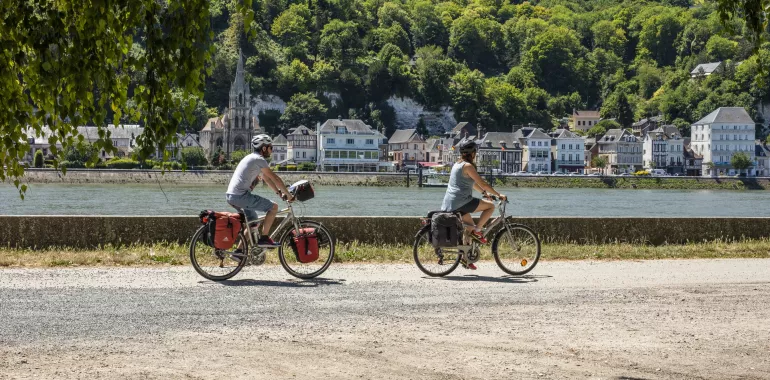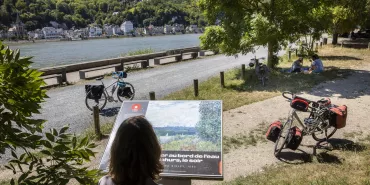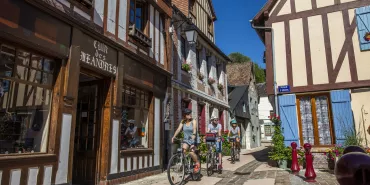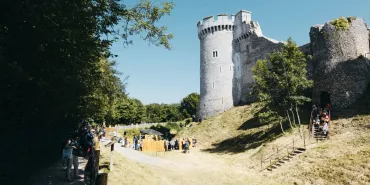Rouen / La Bouille La Seine à Vélo
19,56 km cycling route from Rouen to La Bouille
Elevation of the stage
Waytypes of the stage
Surface of the stage
The route
After Rouen’s quays, the cycle route sticks to hard-surfaced, segregated tracks (either cycle paths or greenways) often shared with walkers (along the Seine’s quays and stretches of towpath).Take particular care cycling along the Seine’s quays through Rouen, even if these are very wide, because there are no barriers to stop you falling into the Seine and there are many walkers and joggers who use the quays too.
Following the path under the Pont Flaubert bridge, be aware that it isn’t obvious how to reach the cycle lane taking you along Avenue Nansen, so watch where you’re going.
You need to use the ferry (bac) from Sahurs to reach La Bouille.
Ferries, or bacs, to cross the Seine
SNCF train stations
- TGV and TER train station in Rouen
- Réseau Astuce Rouen: Metro, bus, Fast, Téor serving the entire Rouen conurbation and the TAE network in Elbeuf serving the Elbeuvienne conurbation and the SNCF railway station located in Saint-Aubin-lès-Elbeuf.
- Long-distance coach station terminal: avenue Champlain (Paris, Caen, Lille)
Cross the Seine by ferry (or bac)
- La Bouille (free for you and your bike)
Don’t miss
- Pont-de-l’Arche and Bonport Abbey: Beside the Seine, visit a Norman abbey founded by Richard Cœur de Lion. Located a one-hour cycle ride south of Rouen, in extensive grounds with views of the river, this Cistercian abbey was begun in 1189 for Richard the Lionheart, following an occasion when he almost drowned crossing the Seine. He made a vow that, if he arrived ‘à bon port’ (safely) on the other bank, he would have a monastery created on the spot. The abbey was sold off in 1791, during the Revolution. A number of the medieval monastic buildings have survived, including the chapterhouse, the work room, the cellar, the kitchens and the 13th-century vaulted refectory. Top tip: explore medieval Pont-de-l’Arche using the dedicated app.
- Circus theatre at Elbeuf: A rarity, with few equivalents in the world of entertainment, the Cirque-Théâtre d’Elbeuf, built in 1892, is one of just eight permanent circus buildings remaining in France. Reopened in 2007, this national centre for circus is a place for creation, production and discovery, as well as for shows and international artistic gatherings. The area having been awarded the label Villes et Pays d’Art et d’Histoire, cultural guided tours are also organized around here.
- Fabrique des Savoirs at Elbeuf (free entry): La Fabrique des Savoirs is run by the Métropole Rouen Normandie (covering the greater Rouen metropolitan area), and is located in the Blin Quarter of Elbeuf. It includes:
- the Musée d’Elbeuf: the Seine is the thread through the museum’s three main sections, divided between natural sciences, archaeology and industrial heritage.
- the Centre d’Archives Patrimoniales: this archive centre holds countless documents, many unique, proving essential sources of knowledge on the history of the parishes concerned and their inhabitants.
- the Centre d’Interprétation de l’Architecture et du Patrimoine: as part of the remit for being awarded Villes et Pays d’Art et d’Histoire status, this place presents a permanent exhibition on the urban and architectural development of the Elbeuf area, with models and audiovisual presentations. - Cathédrale Notre Dame de Rouen: In Rouen’s historic heart, the cathedral offers a fine lesson in the development of Gothic architecture, going from the start of construction in the 12th century, on the foundations of a basilica dating back to the 4th century and a later, Romanesque ensemble from the 11th century. The Vikings had destroyed an earlier church here in 841. In 1944, during World War II, Allied bombs partially destroyed the cathedral. This living momument has changed a lot through time. The metal spire, the tallest in France at 151m, dates from the 19th century. One constant: this is the only cathedral in France to have an adjoining archbishops’ palace still occupied by an archbishop. In the cathedral choir stand the tombs of the Dukes of Normandy, including that of the duchy’s founder, in 911, the Viking Rollo, and that of Richard the Lionheart, King of England as well as Duke of Normandy.
- Le Gros Horloge: A symbol of Rouen, straddling the main, pedestrian shopping street, the architectural ensemble of the Gros Horloge consists of a Gothic belfry, a great arch, a Renaissance clock and an 18th-century fountain. The belfry contains the town bells as well as one of the oldest clock mechanisms in Europe, operational from the 14th century to 1928. Inside, contemporary displays reveal the inner workings of this exceptional monument dedicated to time. Enjoy the dials room, the historic apartments of the clock’s governor, the original town bells and a unique view over the centre of town.
- Quartier des Antiquaires (Saint Maclou): Just east of the cathedral, the cobbled streets of the Quartier Saint Maclou are a joy to explore, with splendid shops and restaurants in magnificent timber-frame houses. Your pedestrian route can lead you up via Place du Lieutenant Aubert to view the great Abbatiale Saint-Ouen, then back down to Place Barthélémy, to admire the Church of Saint-Maclou, its Gothic façade like stone lace. Note the narrow passageways leading off the main streets, a reminder of medieval Rouen. Explore these hidden corners, unearthing architectural treasures. Don’t miss the amazing, restored Aitre Saint Maclou, site of a medieval cemetery, now a normally peaceful, if startling, courtyard.
- Joan of Arc: Joan of Arc is an iconic figure for the city. She is recalled in many streets, squares and monuments around Normandy’s capital. From the Tour de la Pucelle, via Place du Vieux Marché and the Cathédrale Notre-Dame, a trail leads you to the places in town closely associated with her and her fiery death here.
- Historial Jeanne d’Arc in Rouen: This museum dedicated to Joan of Arc lies within the archbishops’ palace, which includes the remnants of the Salle de l’Officialité, where Joan was condemned to death in 1431, but where her second, posthumous trial also took place in 1456, annuling the first. The Historial’s contemporary presentations retrace the many sides to Joan and the many stories associated her, using new technology in a medieval setting.
- Musée des Beaux-Arts: Rouen’s fine arts museum opened in 1809. It’s now considered one of France’s leading museums thanks to its rich collections, covering all periods from the 16th to the 19th centuries, in painting, drawing, sculpture and the decorative arts. Look out for pieces by Caravaggio, Vélasquez, Poussin, Rubens, Puget, Delacroix, Géricault, Modigliani and Duchamp, among others. The museum also boasts the largest collection of Impressionist works outside Paris, with Monet, Pissarro, Renoir and Sisley among those represented. The interior architect Andrée Putman renovated the museum in 1994, creating spacious, luminous rooms, plus there’s a sculpture garden dedicated to contemplation and relaxation.
Parc du Château de Soquence: Visible from the cycle route, the Parc du Château de Soquence offers fine grounds, open to visitors 1 July to 10 August.
- Cross the Seine by ferry (or bac) – it’s free! While the major Norman bridges in these parts may appear to offer the most obvious way to cross the Seine, many people still use the small, free ferries, or bacs, going from one bank to the other. These used to be the only way to get across the lower reaches of the river in the département (county) of Seine-Maritime, but they remain a much-loved tradition, beloved of locals and tourists alike, the former appreciating the social links they provide.
- La Bouille: Birthplace of writer Hector Malot, author of French children’s classic, Sans Famille, this charming Seine-side village sits at the foot of impressive cliffs. Appreciated as a place to get away from the big city of Rouen, La Bouille attracted artists like Sisley and Gauguin, and even Turner, wishing to paint one of the Seine’s most beautiful meanders. La Bouille goes back to Celtic times. By the 11th century, the village’s economy was firmly turned towards the river. In the 14th century, local merchants financed long-distance ventures, trading in exotic goods. The creation of this fleet gave the port major importance, the local economy greatly developing. After World War II, river traffic declined, the village converting to tourism.




Travellers’ reviews